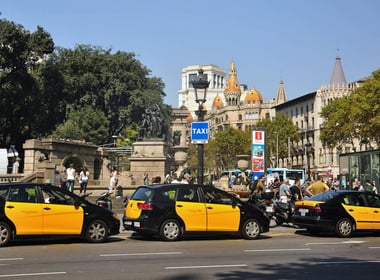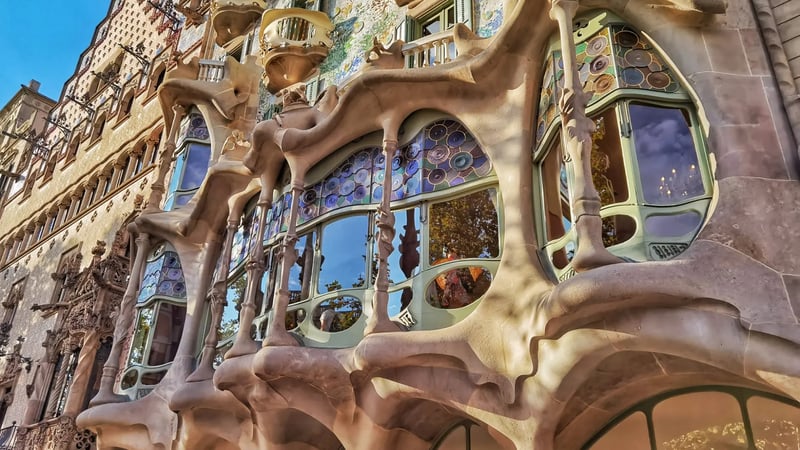İçindekiler
Casa Batllo is one of the most brilliant examples of Antoni Gaudí’s architectural genius. Pushing the boundaries of modernism, this building is considered one of Barcelona’s most iconic landmarks. Shaped by Gaudí’s creativity and innovation, Casa Batllo is of great importance in terms of both architecture and art. In this article, we will examine in detail Casa Batllo’s journey from its origins to the present day, its architectural features and its cultural significance.
The Story of Casa Batllo
The story of Casa Batllo begins in 1904, when Joan Batllo i Casanovas decided to renovate his home. Joan Batllo belonged to one of the richest families in Barcelona and wanted to modernize the existing building on Passeig de Gracia, one of the most prestigious streets in the city. In the process, he commissioned Antoni Gaudi, the most visionary architect of the time, to remake the building he owned.
Gaudi’s Vision: Colors and Organic Forms
When Antoni Gaudi redesigned Casa Batllo, he aimed to create a structure full of organic forms and vibrant colors inspired by nature. Gaudi’s signature curved lines, floral patterns and mosaic details made the building unique among other buildings. With this approach, Gaudi broke traditional architectural molds and transformed Casa Batllo into a work of art.

Aesthetic Elements of Architecture
Exterior The exterior of Casa Batllo is decorated with wavy lines and colorful ceramic mosaics. The building stands out with its balconies resembling seashells and colored glass windows.
Ceiling and Roof: The roof ends with a large terrace resembling a dragon’s back. Covered with green glass mosaics, the roof reflects the sunlight, giving the building a magical feel.
Use of Light: Gaudi designed a glass dome and colorful stained glass to make the most of natural light in the interior. In this way, every corner of the house offers a bright and welcoming atmosphere.
Casa Batllo in Restoration and Modern Times
The modern history of Casa Batllo entered a new era with the extensive restoration work that began in 1986. This delicate process, which was initiated to protect it against the corrosive effects of time, was carried out faithfully to Gaudí’s original vision. The restoration team meticulously handled every detail of the building; the chemical composition of the original materials was analyzed and reproduced with the same techniques.
In particular, the restoration of characteristic elements, such as the colorful ceramic mosaics on the facade and the bone-like columns on the balcony, required great care. By combining traditional techniques used by Gaudí with modern conservation methods, expert craftsmen were able to preserve the authentic character of the building. Completed in 1996, this meticulous work not only strengthened the physical structure of the building, but also ensured that its architectural heritage would be passed on to future generations.
The fruits of this painstaking restoration work were crowned in 2005 when Casa Batllo was inscribed on the UNESCO World Heritage List. Today, the building is one of Barcelona’s most important cultural and touristic centers, welcoming over a million visitors a year. Equipped with a modern museum approach, it offers visitors the opportunity to discover the genius of Gaudi and the fascinating world of modernist architecture.

Architectural and Artistic Features of Casa Batllo
The most striking feature of Casa Batllo is its undulating facade and its surface covered with colorful ceramic mosaics. The facade of the building resembles the skeleton of a sea creature with its undulating forms reminiscent of the sea surface and the bone-like columns on the balcony railings. The roof has a scaly structure reminiscent of a dragon’s back, referencing the legend of St. George slaying the dragon. Gaudí’s nature-inspired design is evident in every corner of the building. The mushroom-shaped frames of the windows, the spine-like structure of the staircase and its spiral forms reflect the mathematics of nature.
Cultural and Touristic Importance
Casa Batllo is not just a building, but one of the most important representatives of Catalan modernism and Art Nouveau. The building is considered one of the works that best reflects Gaudi’s architectural genius and creativity. The originality of the building’s design and the delicacy of the details reflect the social and cultural changes of the period. Casa Batllo has become a symbol of the transition from traditional architecture to modern approaches.

Visitor Experience and Practical Information
Today a museum, Casa Batllo offers a unique experience to its visitors. The main floor of the building is furnished with furniture and decorative items from the period in which the Batllo family lived. Visitors can explore every corner of the building with digital guides and learn in detail about Gaudí’s design philosophy and the technical features of the building. The view of Barcelona from the roof terrace is one of the most impressive moments of the visit.
Gaudi’s Legacy
Beyond being an architectural masterpiece, Casa Batllo is a work that pushes the limits of human creativity and imagination. Gaudí’s unique design approach demonstrates that it is possible to live in harmony with nature and combine the traditional with the modern. Rising in the heart of Barcelona, this fascinating building offers visitors not only an architectural experience but also an artistic journey. If you are visiting Barcelona, you should definitely add this fascinating building to your sightseeing list.
Casa Batlló
Website
https://www.casabatllo.es
Visiting Hours
Weekdays: 08:30 / 22:30
Weekends: 08:30 / 22:30
Address
Pg. de Gràcia, 43, L'Eixample, 08007 Barcelona








